
Australian Journal of Chemistry
Volume 66 Number 2 2013
RESEARCH FRONT: Flow Chemistry
CH13039Flow Chemistry: An Enabling Tool for Chemical Synthesis and Manufacture
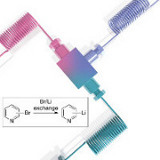
The increasing use of flow chemistry techniques in both research and industry suggests that flow-based chemistry will have significant impact on chemical synthesis. This Research Front showcases some of the cutting edge research that is being conducted in this rapidly emerging field.
CH12465A View Through Novel Process Windows
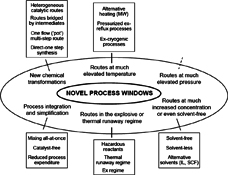
This mini-review discusses some of the recent work on novel process windows by the Micro Flow Chemistry and Process Technology group at the Eindhoven University of Technology, and their associates.
CH12365Flow Microwave Technology and Microreactors in Synthesis
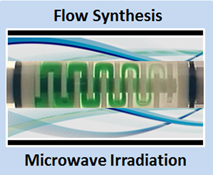
A flow-through microwave reactor has been constructed and tested against an array of standard organic chemical transformations enabling ready scale-up of the processes.
CH12381Continuous Flow Synthesis of Difluoroamine Systems by Direct Fluorination

This paper describes the use of continuous flow methodology for the synthesis of perfluoroaryl difluoroamines by reaction of fluorine gas with perfluoroaniline substrates.
CH12406Continuous Flow Synthesis of Organic Electronic Materials – Case Studies in Methodology Translation and Scale-up
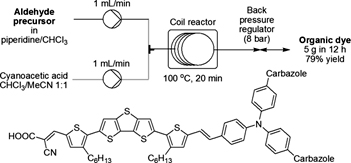
Continuous flow chemistry was applied for the derivatization of alkylthiophene building blocks. The advantages of reaction automation and scale-up were demonstrated for selective lithiation-borylation and Knoevenagel condensation of thiophene derivatives. These synthetic approaches allow facile and rapid access to monomer and dyes for organic electronic applications.
CH12426Continuous Flow Photochemistry for the Rapid and Selective Synthesis of 2’-Deoxy and 2’,3’-Dideoxynucleosides
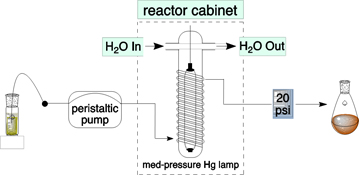
With the development of a new photochemical flow reactor, a multi-step sequence in continuous flow afforded deoxynucleoside drugs in high efficiency.
CH12450Characterization of Dispersion Effects on Reaction Optimization and Scale-Up for a Packed Bed Flow Hydrogenation Reactor
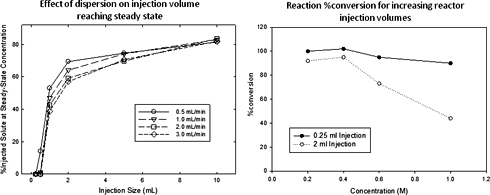
We analyzed the dispersion for a commercial H-Cube® hydrogenation flow chemistry platform and the effects of dispersion on low volume reactions. Attempts to scale reactions <2 mL were shown to be unreliable. Using larger volumes or replicate small injections proved to be a more consistent approach.
CH12435A Two-Stage Continuous-Flow Synthesis of Spirooxazine Photochromic Dyes

A continuous-flow process for the synthesis of several known and previously unreported spirooxazine photochromic dyes is reported. The process proceeds via a copper catalysed addition of substituted anilines to naphthalene-1,2-dione, followed by reaction with 1,3,3-trimethyl-2-methyleneindoline in the presence of hydroxylamine hydrochloride to give the desired spirooxazine products.
CH12463A Multi-Step Continuous Flow Process for the N-Demethylation of Alkaloids
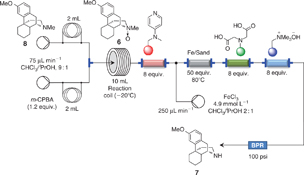
Dextromethorphan was N-demethylated using the non-classical Polonovski reaction under continuous flow conditions, in two steps: initial N-oxidation with m-chloroperbenzoic acid followed by iron-catalysed N-demethylation of the resulting N-oxide.
CH12434Silica Immobilized Hoveyda Type Pre-Catalysts: Convenient and Reusable Heterogeneous Catalysts for Batch and Flow Olefin Metathesis
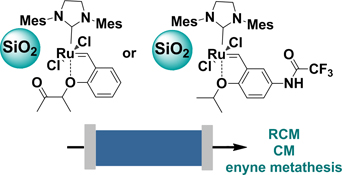
Two Hoveyda-type ruthenium metathesis precatalysts adsorbed on silica served as fixed bed materials in microreactors and showed good catalytic activity and moderate stability in ring-closing, cross, and enyne metathesis reactions under flow conditions.
CH12479Synthesis of RAFT Block Copolymers in a Multi-Stage Continuous Flow Process Inside a Tubular Reactor
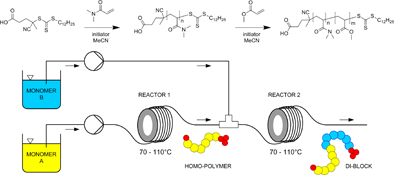
The RAFT method allows polymer chains to be reinitiated and continue to grow, which makes it a very convenient and versatile technique for synthesising complex architectures, such as blocks or stars. We have developed a multi-stage continuous flow process for the RAFT polymerisation of a series of di-block copolymers, including combinations of hydrophilic and hydrophobic blocks.
CH12440Generation and Reactions of Pyridyllithiums via Br/Li Exchange Reactions Using Continuous Flow Microreactor Systems
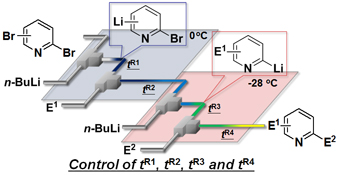
Generation and reactions of pyridyllithiums based on Br/Li exchange reactions can be carried out without using cryogenic conditions by virtue of short residence times and efficient heat transfer. Moreover, sequential introduction of two different electrophiles has been successfully achieved using dibromopyridines in an integrated flow microreactor system.
CH12379Development and Evaluation of a Raman Flow Cell for Monitoring Continuous Flow Reactions

Flow reaction monitoring of a Suzuki reaction with in-line Raman spectroscopic monitoring of reactants and product. Partial least-squares regression (PLSR) was used to obtain a calibration model for the quantification of Suzuki cross coupling reactions. Kinetic studies and flow reaction optimisation have been used to illustrate the inherent advantage of flow methodology over more traditional batch based methodology.
CH12405Visible Light-Initiated Preparation of Functionalized Polystyrene Monoliths for Flow Chemistry
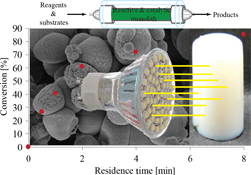
Styrenic monoliths are produced using a novel visible light initiated method. The visible light-initiation protocol enables incorporation of monomers such as a reactive N-hydroxysuccinimidyl (NHS)-ester that are incompatible with thermal or UV-initiated monolith methods. We demonstrate that the monolith is easily functionalized with 4-dimethylaminopyridine (DMAP), that the formed monolith supports acylation reactions well, and that the loading of the catalyst impacts the reaction rate.
CH12367Electrochemical Properties and Regioselectivity of Cyclopalladation of Chiral Ferrocenylimines Deriving from (S)-Ferrocenylethylamine
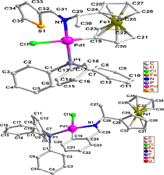
The heteroannular palladacycle (Sc)-3 was obtained from ligand (Sc)-1, while cyclopalladation of ligand (Sc)-4 gave the major endo-palladacycle (Sc)-5 and minor heteroannular palladacycle (Sc)-6. The palladacycle with a σ Pd–Csp2,ferrocene bond facilitated iron(ii) oxidation. The palladacycle containing a σ Pd–Csp2,phenyl bond was less resistant to oxidation. Theoretical studies showed good agreement with experimental results.
CH12422Chemically Modified Lagenaria vulgaris as a Biosorbent for the Removal of CuII from Water

A new method of chemical modification significantly improves the adsorption properties of the low-cost, widely available biomaterial Lagenaria vulgaris for removal of copper from industrial wastewaters.
CH12387A Green Method for Preparing CuCl Nanocrystal in Deep Eutectic Solvent
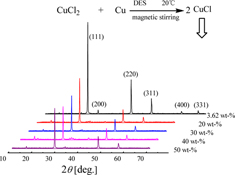
This paper highlights the utilisation of nontoxic, cheap and renewable reactants and environmentally benign solvents in chemical synthesis without the production of pollutive by-products. An environmentally friendly method has been developed for the preparation of high purity lamellar CuCl nanocrystals based on the redox reaction between CuCl2·2H2O and copper powders in the deep eutectic solvent (DES).
CH12359InCl3 Catalysed One-Pot Synthesis of Substituted Pyrroles and 2-Pyrones

A simple multicomponent procedure for the synthesis of tetra-substituted pyrroles was established through a combination of Michael addition and Paal–Knorr methods, whereas tri-substituted 2-pyrones were prepared from a sequential Michael addition and 6-exo-trig cyclisation.
CH12392Electrospun Poly(vinylidene fluoride)-Lithium Bistrifluoromethanesulfonamide Separators for Applications in Ionic Liquid Batteries
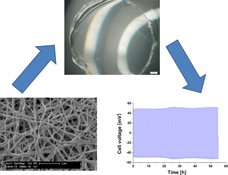
Neat PVDF, LiTFSI-doped PVDF, and two LiTFSI-doped membranes with either thermal or UV cross-linking have been electrospun. Membranes have been characterised with a variety of techniques and assessed for use in ionic liquid battery applications. The membranes show superior performance compared with commercial membranes for the application.
CH12458Eco-Friendly Synthesis of 2-Substituted Benzimidazoles Using Air as the Oxidant

A simple, environmentally friendly procedure for the synthesis of 2-substituted benzimidazoles by the one-pot condensation of o-phenylenediamines with aromatic aldehydes using continuous bubbling of air in absolute ethanol at room temperature is described.



